Abstract
In many European cities, old urban centres, particularly historical centres, reveal significant limitations to the intervention of civil protection agents—namely, firefighters—in terms of their mobility and action in emergencies, thus conditioning their action. This article analyses the case of a Portuguese city (the city of Ílhavo), proposing possible solutions applicable to territories with these specificities. This study was developed with the support of a literature review and field work that accompanied the actions of the local fire department. The proposals include new technical solutions (such as underground dry pipeworks), measures regarding traffic restrictions, the adequacy of signage, and recommendations for training the population living in these areas to intervene in fire situations. This study was developed through monitoring several interventions by the local fire department in real emergencies, allowing for the identification of some existing limitations in its activity resulting from the specific characteristics of the old urban centre. Measures already adopted in other Portuguese cities to improve mobility and reduce the negative impact on firefighters’ work in historical centres are also mentioned. It is also recommended that all civil protection agents be closely involved in planning and designing these urban rehabilitation interventions when carrying them out in these areas.
1. Introduction
1.1. Objectives and Motivation of the Study
Even when subjected to rehabilitation interventions, older urban centres do not generally improve the conditions for civil protection agents to operate, maintaining architectural barriers that compromise, for example, proximity surveillance. This aspect is more noticeable in historical centres, where the maintenance of built heritage generally takes precedence over other urban planning guidelines [1,2,3].
In some countries with centuries-old heritage, such as Portugal, urban rehabilitation interventions in historical centres have, in many cases, conditioned the intervention of civil protection agents; for example, limiting the mobility of firefighters and the capacity for intervention [4,5,6]. Bibliographic research on this issue revealed that the dissemination of knowledge about possible solutions to make heritage maintenance compatible with civil protection requirements is relatively limited, indicating that the number of studies in this area is small or that the specificities of each specific situation recommend a case-by-case analysis [7,8,9].
This article presents the results of a study for the case of the historical centre of the city of Ílhavo, Portugal, proposing measures to improve the situation, including planning infrastructures to combat urban fires, carrying out interventions in the street grid, and providing pre-hospital assistance to victims. The research involved a bibliographic review, which also characterised the scientific community’s level of knowledge about this topic. To better understand the mechanisms of action and limitations of firefighters in old urban centres, the review involved scientific articles, legislation, reports, manuals, and projects [10,11,12,13,14,15], as well as field work monitoring the action of the fire brigade of the local fire department.
1.2. Historical Framework
Fires are a permanent scourge of any urban setting and can occur in all types of buildings. Each year, 10 to 20 people per million lose their lives due to these events. In most developed nations, the total cost of urban fires, including losses and protection, is roughly 1% of the gross domestic product per year [16,17,18,19,20,21].
In the 1960s, there were several severe fires in Europe, such as the fire at the Innovation supermarket in Brussels, which caused more than three hundred deaths, and the fire at the Le Cinq Sept nightclub in Saint-Laurent-du-Pont (France), which led to the emergence of new regulations in several countries. Portugal has not had many relevant events of this type in its recent history [1]. However, the great fire in Lisbon, in Chiado, in August 1988 alerted the community to the importance of fire protection in old urban centres [22,23].
The Chiado fire was particularly violent due to the construction details of the existing buildings, which had a wooden structure that fuelled the fire, contributing to its rapid spread. These buildings have an 18th-century Portuguese architectural style, the “Pombalino style”, which emerged in the reconstruction of Lisbon after the great earthquake of 1755 and which was named in honour of Sebastião José de Carvalho e Melo, Marquis of Pombal, at the time when he was the Secretary of State for the Kingdom. This style is based on a three-dimensional construction system braced in wood, also known as “Pombaline cage” [22,23].
It is worth noting that firefighters faced several difficulties in accessing the site given that, in an urban intervention carried out shortly before, the access road (Rua do Carmo) had been transformed into a pedestrian path with various urban furniture, such as concrete flowerbeds and benches. Problems with firefighting equipment were also reported, with several hydrants not working correctly. This fire caused two deaths (a firefighter and a resident) and many injuries and left several people homeless and, as a result, a broad regulatory framework on this matter was created in Portugal [22,23].
In Portugal, before the existence of urban water distribution systems (which developed from the mid-18th century onwards), fires were fought with buckets of water, which were transported hand to hand from the source of the water to the fire focus, or by using carts with barrels or pipes that helped water to reach the fire more quickly.
At the beginning of the 19th century, with the progressive generalisation of cast iron networks in several European and American cities, accessories with openings, such as tees, began to be installed along networks at regular intervals, enabling water extraction to combat fire [24]. Initially, water collection was performed using small canvas reservoirs. Later, portable pipes began to be used, connecting at one end to a tee and at the other to a hose connected to a hand pump [24]. Fire hydrants (Figure 1) arose from the need to have an easily accessible above-ground water point for fighting fires.
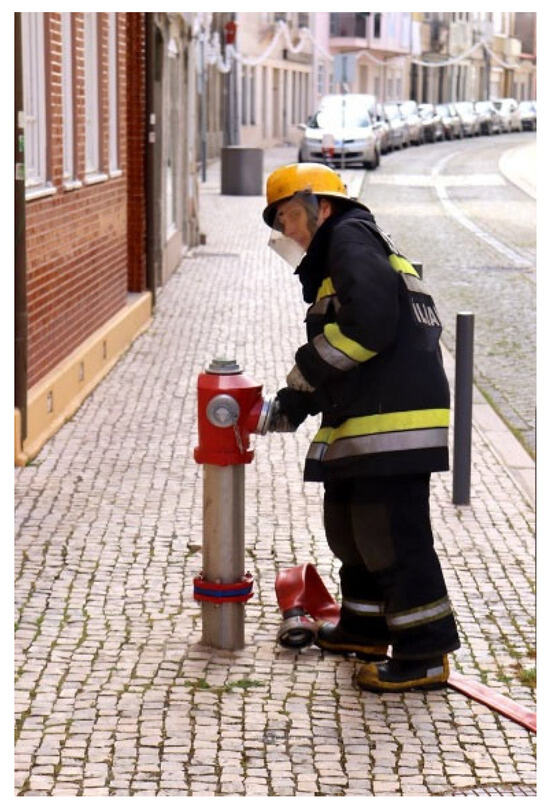
Figure 1.
Example of a fire hydrant in the city of Ílhavo.
While pump technology greatly evolved in the 19th century, methods for the transport of water to fight urban fires did not keep up with this advancement. Thus, it was only at the beginning of the 20th century that motor vehicles began to transport firefighting equipment and, later, airplanes were also used to directly assist in the fight.
It is also important to note that the incorporation of Industry 4.0 makes it possible to improve fire safety and management [25].
2. Materials and Methods
Over time, the means used by firefighters were naturally improved, as were the techniques for fighting fires. However, fires have also become more complex through the influence of new materials, technologies, and construction features used in rehabilitation works and new constructions [26,27,28].
Humanitarian associations of volunteer firefighters were created in Portugal in the 19th century, which were accompanied by the first initiatives toward municipal civil protection. Throughout the 20th century, several pieces of legislation were published in this context, with the creation of the National Fire and Civil Protection Service in 2003, which later evolved (in 2019) into the current National Emergency and Civil Protection Authority.
This study aimed to identify the main constraints on firefighters’ work in an old urban centre and find solutions to improve the situation; the fundamental methodology included carrying out field work, which involved monitoring various interventions by firefighters in the urban centre of a Portuguese city (Ílhavo). This field work also provided an opportunity to analyse and discuss possible solutions to the observed constraints “in loco” with civil protection agents. Consulting bibliographical references in this field provided another way of researching solutions proposed in other contexts, naturally verifying their applicability to local reality.
The city of Ílhavo, located south of the Aveiro district, near the sea, is distinguished by the layout of its old centre. This centre is essentially made up of alleys and lanes, making it almost a labyrinth.
Around the 18th century, the urban area consisted of typical alleys, where inhabitants with fewer resources and people who did not work in agriculture (artisans, fishermen, etc.) settled. This “old town” is physically and functionally connected to the city’s structured urban axis.
In Figure 2, the area outlined in red represents the area under study. The streets are narrow, with most having dead ends (some are only 2.30 m wide). This circumstance makes vehicle access difficult, especially for larger ones, such as firefighting vehicles. These streets are mostly made of cobblestone.
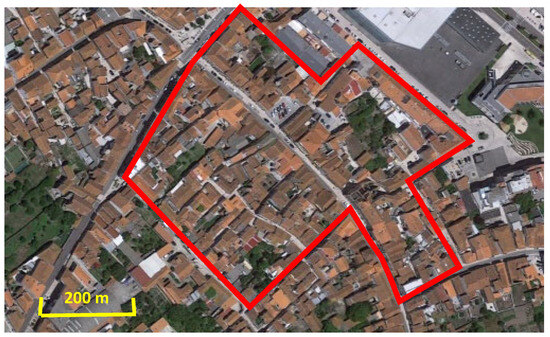
Figure 2.
Study area.
The field work for this study took place over the course of a calendar year, from mid-2023 to mid-2024. During this period, Ílhavo firefighters carried out 60 interventions in the urban centre area, resolving various types of claims or accidents, and the first author accompanied most of these interventions with the command. The first author followed an observational approach and, during these visits, made a written and/or photographic record of the main constraints faced by firefighters. Recurring problems, detected in previous interventions, were not recorded. Subsequently, these records and the information collected in the field were analysed and discussed with the other authors, seeking solutions to resolve the observed restrictions.
During this phase, diverse studies were consulted [1,3,5,6,7,8,9,10,15,16,17,18,19,20,21,22,23], seeking to learn about solutions already proposed in other Portuguese cities or in other countries when faced with similar situations. However, the present study naturally observed the requirements of the regulations in force in Portugal, which is why greater relevance was given to the interventions known in Portugal, which are highlighted below. In any case, in relation to most of the constraints detected in Ílhavo, no references to similar situations were found.
Based on the authors’ knowledge, field observations, and the references consulted, the following section presents some general considerations regarding the constraints on firefighters’ mobility in old urban centres/historical areas and about the specific situations found in Ílhavo, as well as a brief description of the solutions implemented in other Portuguese cities.
3. Survey of Constraints on Firefighters’ Mobility in Old Urban Centres/Historical Areas
Fire safety in buildings is a subject of great importance to society. To limit the consequences of an urban fire, it is necessary to consider measures to reduce the risk of fire and improve buildings to withstand such occurrences. Risk reduction measures may include preventive, passive, or active protection measures. Risk assessments can be carried out to determine which measures to apply [15].
Fire safety in buildings should not be limited to implementing new safety techniques and encouraging the creation of new construction methods. It should also include informing the population about the importance of fire prevention [10]. A lack of fire safety can irreversibly compromise historical and cultural heritage as it is generally challenging to reconstruct works of art and historical heritage. The recent fire at the Notre-Dame Cathedral in Paris is a good example.
In buildings located in old urban centres, it is necessary to consider that there was no fire safety regulation at the time of their construction, making the mission of protecting these buildings more difficult. In addition to the architectural solutions of the buildings, the materials used are also different, and uses of the building itself also often change over time.
All of these aspects make buildings in historical centres a sensitive fire safety issue. Therefore, it is essential to analyse the fire safety of historical centres in a prudent and detailed manner. In most cases, fire safety legislation does not meet the requirements of old urban centres and their buildings, meaning that the measures provided in regulations are often impossible to implement.
Historical urban centres began to be located, more or less geometrically, in the centre of cities, where the population is concentrated and the most accessible and protected areas for main activities are located. Over time, several factors have led to the progressive abandonment of many historical urban centres, which are currently degraded and aged. However, there are known cases of rehabilitation in these areas, with the aim of exploiting their tourist potential in many cases.
In general, old urban centres present the following characteristics associated with the subject of this article:
- (a)
- Streets with limited dimensions and difficult access for firefighting and rescue vehicles;
- (b)
- Paths with reduced dimensions, which increase the spread of fire through radiation and convection;
- (c)
- A lack of spacing between buildings, which increase the spread of fire;
- (d)
- Changes in the use of buildings without necessary adaptations regarding fire safety (e.g., residential to commercial uses);
- (e)
- The existence of unoccupied and deteriorated buildings, which increase the spread of fire;
- (f)
- The inadequate application of materials in buildings, both inside and outside (original or undergoing renovation), which are often combustible;
- (g)
- The presence of an older population with slower and more restricted movement (which naturally requires the existence of adequate accessibility and mobility conditions [10]).
Urban morphology characterised by narrow streets is very common in old urban centres, making access difficult, for example, for fire trucks. Therefore, any intervention by firefighters takes longer than desired, compromising the protection of people and property. Figure 3 and Figure 4 show examples of narrow streets typical in the historical centre of Ílhavo.
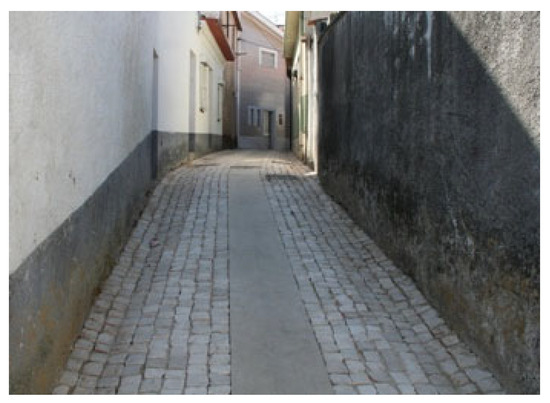
Figure 3.
Street in the old town of Ílhavo.

Figure 4.
Photo of the old urban centre of Ílhavo (the old “urban hull” of the city).
It should be emphasised that accessibility and mobility are important concepts in this context. Architectural barriers in squares, the blocking of streets with urban equipment or street furniture, and the transition of streets to strictly pedestrian paths are several elements that create constraints on the movement of firefighter vehicles and their intervention and performance. It is also important to note that the very configuration of old urban centres creates even more difficulties in circulation.
In addition to narrow streets, parking (often abusive) in old urban centres is also a barrier that affects the actions of firefighters. Thus, in parallel to rehabilitation interventions, solutions must be created to lower the number of vehicles circulating and parking in historical centres. However, this problem is not easy to solve and may contribute to the desertification of the urban centre (due to the limitations that this situation creates, for example, for residents with reduced mobility).
It is clear that the very narrow streets, especially in historical areas, and the need for residents to park their vehicles there (given the absence of garages in old buildings), mean that vehicles are parked in places that compromise the action of firefighters in the event of an accident. The placement and distribution of outdoor urban equipment, such as fire hydrants, lamps, vertical signage, or trash cans, are also often obstacles for firefighters.
The risk of a fire in an area where the fire department’s resources cannot reach translates into a redoubled concern for the people responsible for attending to crises in that area and for those who live there. In historical centres, firefighting resources, namely external hydrants, are often scarce, or those that exist are blocked (by vehicles, etc.), constituting yet another difficulty for firefighters.
While it is true that each historical centre has its own specificities and that fire prevention measures are not always generalisable, Table 1 lists some good practices adopted in other Portuguese cities that can also be applied in Ílhavo. In promoting fire prevention in old urban centres, it is important to have information about unoccupied residences to reduce the risk of ignition (cutting off electricity, gas, etc.) and to promote awareness among the population about the problem of urban fires (with training, qualification, etc.).

Table 1.
Summary of some measures for fire prevention in historical centres already adopted in other Portuguese cities.
4. Results and Discussion
The study area is currently characterised by traditional buildings, mainly used for housing, with very diverse rehabilitation interventions over the years in terms of materials, finishes, colours, etc., leading to some mischaracterisation. As seen in Figure 5, almost all buildings are in rows on long and narrow streets, so fires can spread quickly and easily.
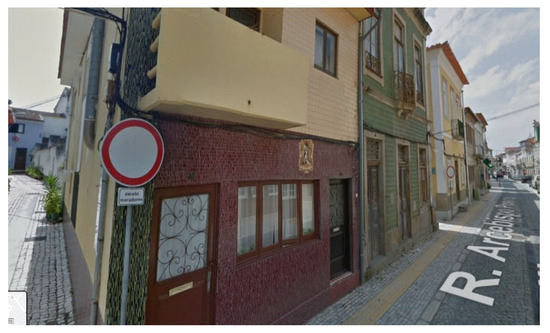
Figure 5.
Typology of current buildings.
Most buildings have different external heights (Figure 6), facilitating fire spread through the roofs. Figure 7 and Figure 8 show accessibility constraints imposed by the parking lane and vertical signage.

Figure 6.
Buildings with different heights.
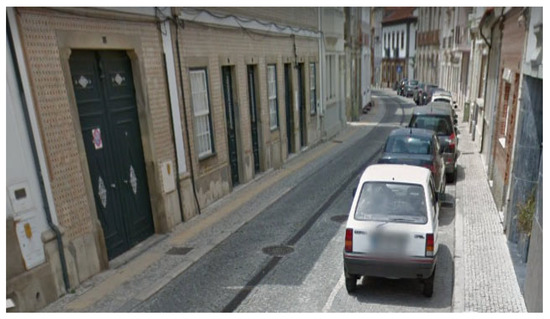
Figure 7.
Archbishop Pereira Bilhano Street.
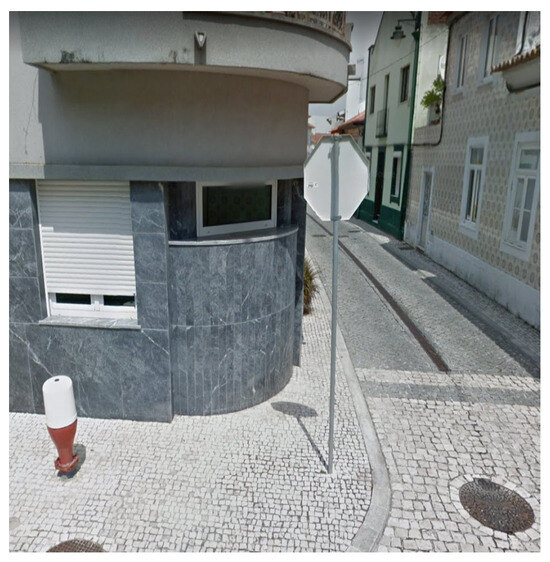
Figure 8.
Tenente Valadim Street.
In the case of Ílhavo, as in other ancient urban centres, firefighters have evident difficulties working in old urban centres due to factors such as accessibility limitations, which increase the time taken to arrive at the intervention site. The existence of parking spots in areas with traffic lanes (that are already limited in size) makes it more difficult to provide assistance in the event of a fire or other emergencies.
Installed vertical signage also constitutes an obstacle to manoeuvring fire trucks (Figure 9). Due to their dimensions, these vehicles need a larger radius of curvature to manoeuvre. Rescue vehicles should be considered alongside passenger vehicles when installing vertical signage. Another difficulty is related to improper parking on public streets and the lack of a safety culture, which lead to constraints in the passage of emergency vehicles (Figure 10).
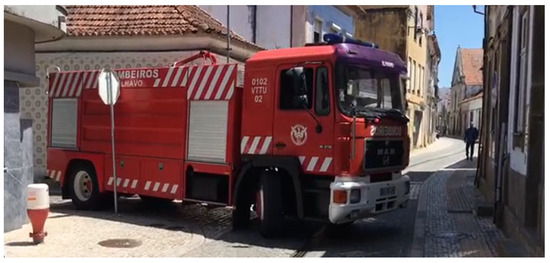
Figure 9.
Vertical signage obstructing vehicle passage.

Figure 10.
Parked vehicle limiting passage of emergency vehicle.
Even without parking, narrow streets and tight alleys make it difficult for emergency vehicles to pass, thus increasing the time spent on manoeuvres, which causes delays in arriving at the accident scene and, consequently, delays in providing assistance and fighting fires (Figure 11). Figure 12 and Figure 13 show some vehicles commonly used to fight urban fires.
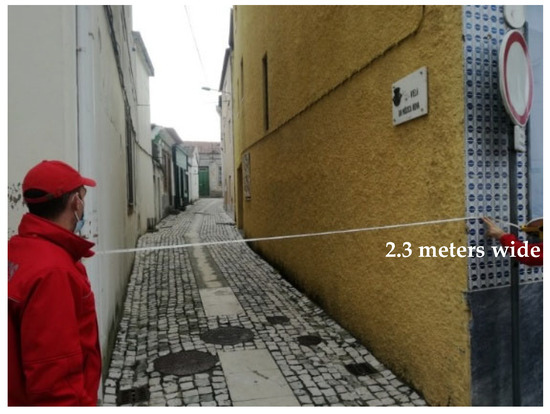
Figure 11.
Narrow streets (e.g., 2.3 m wide).
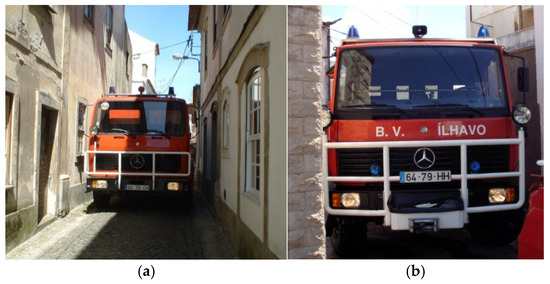
Figure 12.
Examples of vehicles in narrow streets. (a) Situation 1. (b) Situation 2.
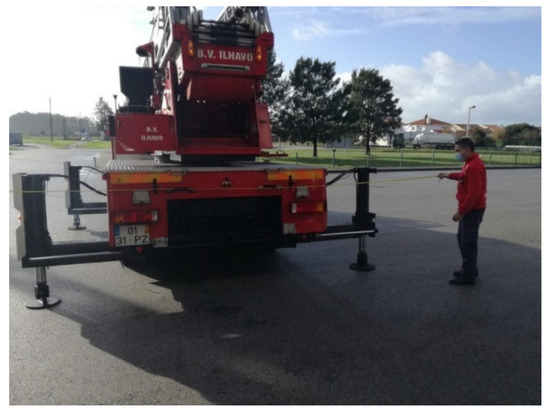
Figure 13.
Vehicle with ladder.
It is important to highlight that these vehicles have a width varying from 2.7 to 3.4 m (Table 2). Given the complexity and type of existing construction, as previously mentioned, as well as the water capacity of the main, interventions in these locations require the mobilisation of numerous resources to the theatre of operations: for example, two Urban Firefighting Vehicles (UFFVs), two Urban Tactical Tank Vehicles (UTTVs) (Figure 14), one Rescue Ambulance (RA), and one Command Vehicle (CV) simultaneously. This equipment is necessary due to the configuration and layout of the residences, the limited availability of fire hydrants, and the lack of pressure in the main so that adjacent residences can be protected. A Ladder Vehicle (LV) may also be required, as well as a Special Logistics Support Vehicle (SLSV).

Table 2.
Examples of vehicle dimensions.
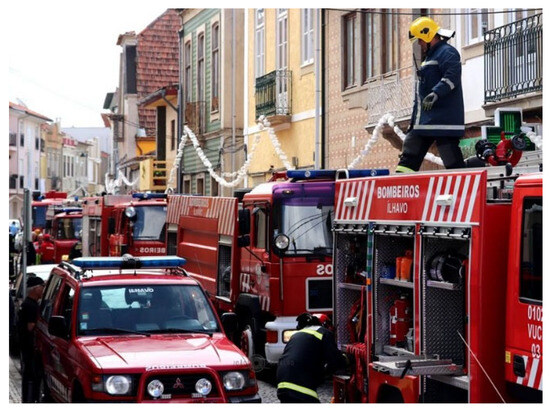
Figure 14.
Difficulties in action.
Table 2 shows the dimensions of commonly used vehicles, including the working areas required for their operation. It should be noted that in the case of a vehicle with a ladder, a large area for stabilisation (4.6 m) is required.
There are limitations in removing the material needed to fight a fire due to the width of the street itself as this material is stored on the sides of the vehicles (Figure 15). Narrow streets make it necessary for firefighters to stop vehicles on the main street and transport materials (stretch hoses, etc.) from this area to the affected area, which may be a few hundred meters away in some situations, through the labyrinths of alleys (Figure 16).
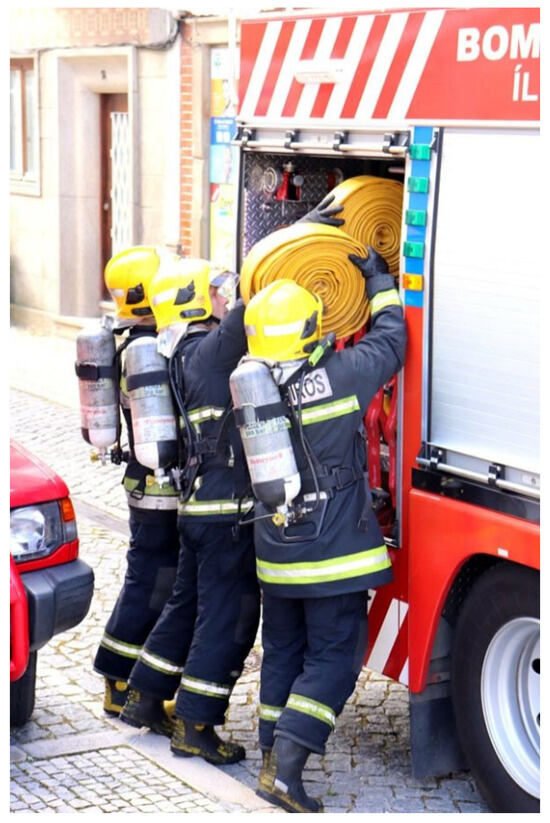
Figure 15.
Removal of material.
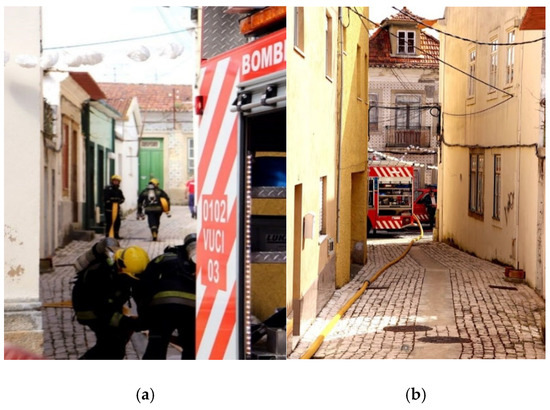
Figure 16.
(a) Transporting materials from the vehicle. (b) Established means.
Poorly parked vehicles, construction work, and other specific obstacles often make it necessary for firefighters to enter the affected zone in the opposite direction to provide assistance (Figure 17). In these places, ladder vehicles also have difficulty manoeuvring. In addition to having difficulty moving around the area due to their size, these vehicles also need extra space to stabilise and manoeuvre, as mentioned earlier, which prevents their use given the width of the streets and the existence of parking on public roads. Therefore, support for operations, whether in fighting fires or rescuing people, must be provided using manual ladders (Figure 18).

Figure 17.
Vehicle entering in the opposite direction.
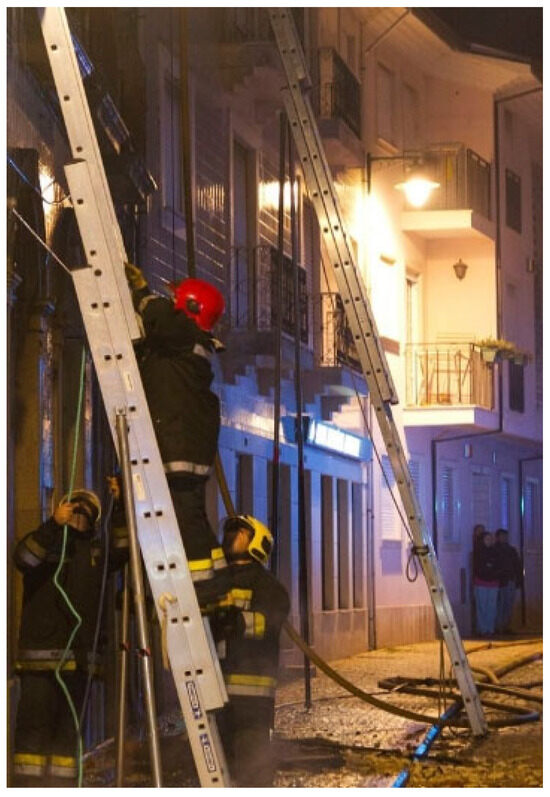
Figure 18.
Use of manual ladders.
There is difficulty in obtaining water to fight fires in all the nooks and crannies of the alleys in these areas, aggravated by the existence of minimum diameters in the main street, which do not meet the conditions for the installation of fire hydrants. A solution could be installing a horizontal dry pipework, similar to the vertical dry riser used in tall buildings. This network, possibly buried, would allow water to be quickly transported from the vehicle’s stopping point to more distant points, with adequate pressure and flow rate.
This buried dry pipework can be implemented simply and at a relatively low cost, with accessories that are currently used in other indoor and outdoor firefighting systems. An inlet similar to that used in dry risers in buildings (Figure 19a) in a location accessible to firefighters’ vehicles, a buried pipe (diameter 80 m or 100 mm), and outlets near the most critical locations, which can be buried (Figure 19b) or placed in a fixed cabinet on exterior walls (Figure 19c), will be sufficient. Based on current prices in Portugal, the estimated cost of a dry pipework approximately 200 m long with these characteristics is EUR 16,000, a value that can easily be justified in many situations considering the degree of risk in the area and the costs associated with a possible urban fire.
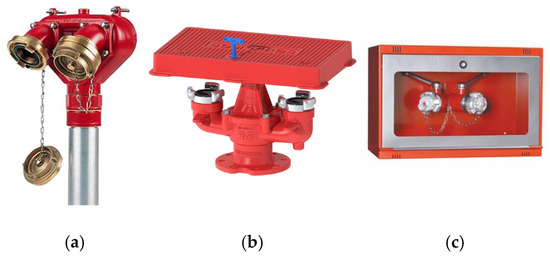
Figure 19.
Accessories for possible buried dry pipework (IMPARTE and AVK catalogues). (a) Dry pipe inlet; (b) Buried outlet hydrant; (c) Outlet hydrant in wall cabinet.
Considering a common scenario, where a house is 200 m from the main street where firefighting vehicles can stop, it is currently necessary to establish a supply hose line to a logistics base (Figure 20) and carry out the fire attack from there. The hoses have a standard length of 20 m, so in this case, 10 lengths of 70 mm would be needed just to carry the water to the logistics base. Afterwards, 45 mm hoses must be connected to fight the fire itself.
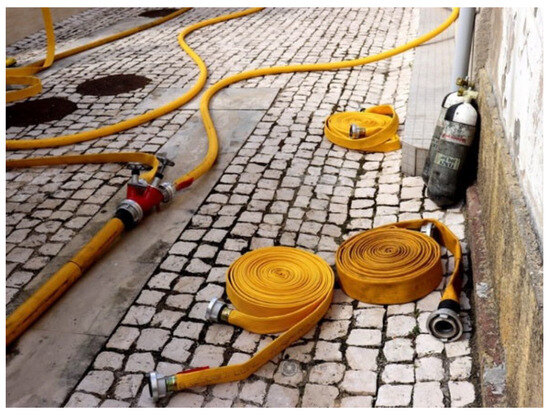
Figure 20.
Logistics base. Materials used in fighting urban fires.
The minimum time for these operations is 5 min. Although it can be said that 5 min is a short time, in a fire scenario, every minute can make a difference regardless of the fire’s size.
It is also important to note that during these interventions, the individual equipment that each firefighter takes to an urban fire weighs around 20 kg, and in current conditions, they have to travel long distances with this equipment in these old urban centres. In short, the existence of these horizontal dry pipes would make it possible to reduce the initial intervention time and manage the physical availability of firefighters.
Although there are no references to this possible solution in the consulted literature, it is worth highlighting that this proposal is considered technically and economically supported for the case under study according to the above data. It was also considered suitable by the local fire department as a viable and interesting solution.
As previously mentioned, another constraint in the old urban centre of Ílhavo is parking on the streets, which are already small. Some parking bays have been created, but due to the increasing number of vehicles, it is necessary to find new parking solutions within the scope of urban planning (creating nearby parks, etc.).
One solution for these cases, when possible, is to create public parks around the urban centre with quick access to the urban core. To limit abusive parking, one possible measure is, obviously, greater police control. These proposals will not be unprecedented as this problem is frequently mentioned in documents or news published after disasters in old urban centres, and they can be found in public action plans of several Portuguese municipalities [5,9,29,30,31].
Another limitation to firefighters’ work, linked to parking vehicles on the streets, is related to health, including pre-hospital assistance and the transport of non-urgent patients (Figure 21). To assist the population in these locations, it is necessary to leave the emergency vehicle or transport vehicle on the main street and then travel through smaller streets and alleys, carrying the stretcher and all the materials necessary for rescue and transport. It is also important to mention that the vehicle must remain stopped on the main road, momentarily preventing circulation, as there is no stopping place for these vehicles (Figure 22).
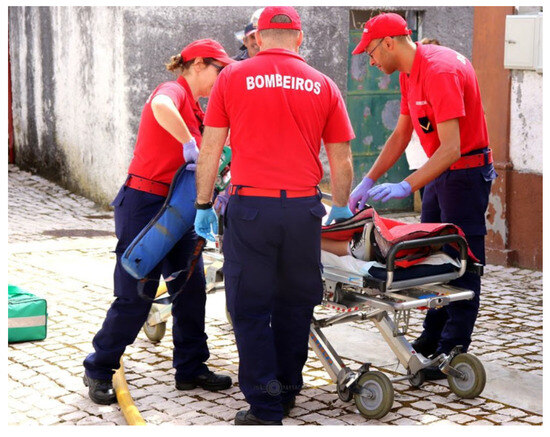
Figure 21.
Pre-hospital emergency.
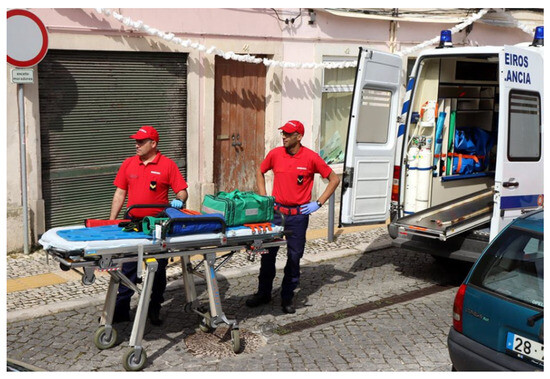
Figure 22.
Ambulance stopped on the road.
One possibility in this field is to make these areas strictly pedestrian areas with limited access and vehicle permanence, and for this purpose, equipment could be used, such as automatic barriers (which can be activated through emergency control centres) to allow access only to authorised vehicles. This measure must eventually be accompanied by solutions for parking vehicles for residents, especially those who are elderly or have reduced mobility.
This solution has been used in different contexts where the aim is to limit vehicle circulation in urban spaces, and it is therefore not unprecedented but will naturally have to be adapted to local reality [31,32,33].
Another possible aspect of action is providing information to train the resident population. Developing a safety culture is essential to improving the safety conditions of the population. It is essential to know how to prevent, alert, and carry out an initial intervention to delay/contain the evolution of the fire until emergency services arrive. For this paradigm shift to occur, it will be necessary to involve the population in awareness-raising actions, training, and simulations developed by local public authorities, fire departments, and other civil protection agents in the municipality.
In terms of prevention, periodic inspections/surveys should be carried out on the circulation conditions of streets, parking lots, water supply conditions, signage, and fire safety conditions of buildings in these areas, minimising potential fire risks or impediments in firefighters’ interventions.
These measures are also not unprecedented in individual terms, and references to partial interventions in Portugal in this context can be found in the consulted literature [1,3,5]. However, from a civil protection perspective, it is important to consider a comprehensive and integrated approach.
Another concern is, without a doubt, that there are some houses whose state of conservation poses a potential fire risk. It is considered that a permanently updated register of unoccupied houses and the confirmation of electricity and gas cuts can also make a positive contribution to preventing fire outbreaks.
Finally, to improve mobility and reduce the negative impact on firefighters’ work in old urban centres, when these areas are rehabilitated, there must be greater involvement of all civil protection agents in these studies. Although the type of fire trucks is identical throughout the country, these vehicles and their dimensions may differ. Therefore, priority should be given to this local articulation to better adapt conditions to the means existing in each municipality.
5. Conclusions
Old urban centres, even after rehabilitation interventions, generally present conditions that make it difficult for civil protection agents to access these locations, mainly due to aero-architectural and urban barriers. Urban rehabilitation in these urban centres should not be limited to streets, sidewalks, or built interventions and should also reflect compatibility between urban planning, architecture, security, and mobility.
When heritage preservation does not allow for street dimensions to be adapted, and where it is not considered feasible to limit the circulation of residents’ vehicles and/or their parking, mitigating solutions must be provided. Abusive parking, on the other hand, hinders the movement of rescue vehicles, increasing the time spent on manoeuvres, which causes delays in arriving at the scene of the accident. Installed vertical signage can also be an obstacle to the manoeuvring of fire trucks given the dimensions of these vehicles.
Water supply conditions in old urban areas also present, in some cases, limitations regarding the availability of flows/pressures and the placement of hydrants. The possibility of unconventional and innovative solutions (such as buried dry pipes) must be analysed.
Several measures suggested in this study to address the constraints encountered in monitoring the activity of firefighters in the centre of Ílhavo are easy to implement in the short term (for example, installing dry buried pipework or reviewing the placement of signage), while others require a more complex urban planning study (as is the case with resolving the parking problem). In any case, all of these measures will be valid in the long term once implemented, and it is not expected that they will become inadequate or require adaptation in the near future.
Developing a safety culture is also an essential aspect of improving the safety conditions of residents in old urban centres. To this end, it is necessary to involve the population in awareness-raising actions, training, and simulations developed by the local public authorities of the municipality, fire department, and other civil protection agents. Periodic inspections of the traffic conditions of streets, parking lots, water supply conditions, signage, and fire safety conditions of buildings in these areas must also be carried out to minimise the risk of fire or impediments to firefighter interventions.
The main strength of this study is the on-site identification of limitations in the study area. One of the weaknesses is that several scenarios involving the population were not simulated.
Although there are regional similarities in the general characteristics of urban centres, there is difficulty in generalising the conclusions, which represents another limitation. Other similar studies carried out in other urban centres may, however, indicate common problems and the possibility of applying identical solutions. Therefore, future work should replicate this type of study in other places in an attempt to complete the knowledge in this field and develop generalisable solutions. Future studies may also monitor and evaluate the results of some of the measures identified in this article once they are implemented.
Author Contributions
Conceptualisation, P.B. and A.S.-A.; methodology, P.B. and C.P.-R.; validation, P.B., C.P.-R. and A.S.-A.; formal analysis, P.B. and A.S.-A.; investigation, P.B., C.P.-R. and A.S.-A.; data curation, P.B.; writing—original draft preparation, P.B. and A.S.-A.; writing—review and editing, C.P.-R.; visualisation, P.B. and C.P.-R.; supervision, A.S.-A. All authors have read and agreed to the published version of the manuscript.
Funding
This research received no external funding.
Data Availability Statement
The original contributions presented in this study are included in the article. Further inquiries can be directed to the corresponding author.
Conflicts of Interest
The authors declare no conflicts of interest.
References
- Calmeiro dos Santos, C.; Correia, J.; Correia, A.; Meneses, S.; Tavares, P. Fire risk assessment in old urban areas—Coimbra old town. In Proceedings of the IFireSS 2017—2nd International Fire Safety Symposium, Naples, Italy, 7–9 June 2017; pp. 1013–1022. [Google Scholar]
- Hebbert, M. The long after-life of Christopher Wren’s short-lived London plan of 1666. Plan. Perspect. 2018, 35, 231–252. [Google Scholar] [CrossRef]
- Santana, M.L.A.; Rodrigues, J.P.; Coelho, A.L.; Charreau, G.L. Fire risk assessment of historical areas: The case of Montemor-o-Velho. In WIT Transactions on Engineering Sciences; WIT Press: Southampton, UK, 2007; Volume 58, pp. 81–90. [Google Scholar] [CrossRef]
- Bispo, R.; Marques, F.J.; Penha, A.; Espadinha-Cruz, P.; Grilo, A. A decade of urban fires: Portuguese events between 2013 and 2022. Sci. Data 2023, 10, 569. [Google Scholar] [CrossRef] [PubMed]
- Figueiredo, P. Análise de risco de incêndio na baixa de Coimbra. Master’s Thesis, Urban Fire Safety, Faculty of Science and Technology, University of Coimbra, Coimbra, Portugal, 2008. (In Portuguese). [Google Scholar]
- Pais, C.; Pereira, S.; Oliveira, S.C. Multi-scale Residential Fire Susceptibility in the Lisbon Metropolitan Area. In Multi-Risk Interactions Towards Resilient and Sustainable Cities; Advances in Sustainability Science and Technology; Ferreira, T.M., Ed.; Springer Nature: Berlin/Heidelberg, Germany, 2023. [Google Scholar] [CrossRef]
- Giuliani, F.; De Paoli, R.G.; Di Miceli, E. A risk-reduction framework for urban cultural heritage: A comparative study on Italian historic centres. J. Cult. Herit. Manag. Sustain. Dev. 2021, 11, 499–515. [Google Scholar] [CrossRef]
- Bosher, L.; Kim, D.; Okubo, T.; Chmutina, K.; Jigyasu, R. Dealing with multiple hazards and threats on cultural heritage sites:an assessment of 80 case studies. Special Issue: Securing Future of Heritage by Reducing Risks and Building Resilience. Disaster Prev. Manag. 2020, 29, 109–128. [Google Scholar] [CrossRef]
- CIVVIH. The Valletta Principles for the Safeguarding and Management of Historic Cities, Towns and Urban Areas. CIVVIH (ICOMOS—International Committee on Historical Towns and Villages). 2011. Available online: https://civvih.icomos.org/vallettaprinciples-english-french/ (accessed on 16 January 2025).
- Fire Safety Engineering Applied To. 2018. Available online: https://www.fireseat.eng.ed.ac.uk/publications (accessed on 16 January 2025).
- Portugal. Decree-Law n.o 45/2019 of 1st of April, AR, (Orgânica da Autoridade Nacional de Emergência e Proteção Civil (ANEPC)), pp. 1798–1808. Available online: https://data.dre.pt/eli/dec-lei/45/2019/04/01/p/dre/pt/html (accessed on 16 January 2025). (In Portuguese).
- Portugal. Decree-Law no 49/2003 of 25th of March do Ministério da Administração Interna, AR, pp. 1930–1943. Available online: https://dre.pt/application/file/231058 (accessed on 16 January 2025). (In Portuguese).
- Pimentel-Rodrigues, C.; Almeida, J.; Silva-Afonso, A.; Barreirinha, P. Impact of Urban Fires in Drainage Systems: An Experimental Case Study. WSEAS Trans. Environ. Dev. 2021, 17, 128–137. [Google Scholar] [CrossRef]
- World Bank Forum. Urban Fires: Here’s How to Build Safer Cities, Urban Transformation; World Bank Forum: Washington, DC, USA, 2021. [Google Scholar]
- Ferreira, T.M.; Vicente, R.; Raimundo Mendes da Silva, J.A.; Varum, H.; Costa, A.; Maio, R. Urban fire risk: Evaluation and emergency planning. J. Cult. Herit. 2016, 20, 739–745. [Google Scholar] [CrossRef]
- Mandalapu, A.; Seong, K.; Jiao, J. Evaluating urban fire vulnerability and accessibility to fire stations and hospitals in Austin, Texas. PLoS Clim. 2024, 3, e0000448. [Google Scholar] [CrossRef]
- Vukomanovic, J.; Doumas, S.L.; Osterkamp, W.R.; Orr, B.J. Housing Density and Ecosystem Function: Comparing the Impacts of Rural, Exurban, and Suburban Densities on Fire Hazard, Water Availability, and House and Road Distance Effects. Land 2013, 2, 656–677. [Google Scholar] [CrossRef]
- Goswami, S.; Kolte, R.; Kumar, A.; Pipralia, S. Fire Hazard In Urban Areas: A Scoping Review to Understand Issues and Opportunities. J. Inst. Eng. India Ser. A 2024, 105, 741–747. [Google Scholar] [CrossRef]
- Morgan, J.E. The representation and experience of English urban fire disasters, c.1580–1640. Hist. Res. 2016, 89, 268–293. [Google Scholar] [CrossRef][Green Version]
- Wagner, P.; Sokolov, S. The Challenges of Disaster Planning, Management, and Resilience, Chapter 16. In 100 Years—100 Cities: Evaluation of Urban Fire Risks; Center of Fire Statistics of CTIF: Berlin, Germany, 2023; ISBN 979-8-88697-229-0. [Google Scholar] [CrossRef]
- Masoumi, Z.; van L.Genderen, J.; Maleki, J. Fire Risk Assessment in Dense Urban Areas Using Information Fusion Techniques. ISPRS Int. J. Geo-Inf. 2019, 8, 579. [Google Scholar] [CrossRef]
- Ochôa, R.; Pratas, J.; Ricardo, F.; Cunha, A. O Grande Incêndio do Chiado; Tinta da China: Lisboa, Portugal, 2013; ISBN 9789896711740. (In Portuguese) [Google Scholar]
- Yamba, S.E. A importância da acessibilidade e da mobilidade na reabilitação urbana: O caso de Lisboa. Universidade Lusíada. 2017. Available online: http://hdl.handle.net/11067/3080 (accessed on 10 February 2025). (In Portuguese).
- Smith, J. A Critical Evaluation of Water Mist, Aqueous Film Forming Foam (AFFF), Wet Chemical, Dry Powder and Carbon Dioxine Fire Extinguishers When Used on Fires Involving Vegetable-Based Cooking Oils. Bachelor’s Thesis, Glasgow Caledonian University, Glasgow, UK, 2019. [Google Scholar]
- Negi, P.; Pathani, A.; Bhatt, B.C.; Swami, S.; Singh, R.; Gehlot, A.; Thakur, A.K.; Gupta, L.R.; Priyadarshi, N.; Twala, B.; et al. Integration of Industry 4.0 Technologies in Fire and Safety Management. Fire 2024, 7, 335. [Google Scholar] [CrossRef]
- Xiong, Y.; Li, G. Correlation Characteristics Between Urban Fires and Urban Functional Spaces: A Study Based on Point of Interest Data and Ripley’s K-Function. ISPRS Int. J. Geo-Inf. 2025, 14, 45. [Google Scholar] [CrossRef]
- Gernay, T.; Selamet, S.; Tondini, N.; Khorasani, N.E. Urban infrastructure resilience to fire disaster: An overview. Procedia Eng. 2016, 161, 1801–1805. [Google Scholar] [CrossRef]
- Moshashaei, P.; Alizadeh, S. Fire risk assessment: A systematic review of the methodology and functional areas. Iran. J. Health Saf. Environ. 2017, 4, 654–669. [Google Scholar]
- Fernandes, J.A.R. Centro histórico e urbanismo: Questões, reflexões e inquietações, a propósito do Porto; Universidade do Porto, Faculdade de Letras, Departamento de Ciências e Técnicas do Património: Porto, Portugal, 2011. (In Portuguese) [Google Scholar]
- Ornelas, C.; Guedes, J.; Breda-Vázquez, I.; Guinea, V.; Turri, A. Urban heritage rehabilitation: Institutional stakeholders’ contributions to improve implementation of urban and building regulations. Urban Plan. 2023, 8, 137–150. [Google Scholar] [CrossRef]
- Silva, A. Historic Urban Landscape Approach and Spatial Planning: Exploring the Integration of Heritage Issues in Local Planning in Portugal. Master’s Thesis, University of Lisbon, Lisbon, Portugal, 2017. Available online: https://fenix.tecnico.ulisboa.pt/cursos/muot/dissertacao/1409728525632032 (accessed on 20 February 2025).
- Blumenfeld, L.E.; Nimrod, S.; Jinxiao, D.; Guanwen, Z.; Shlomo, H. Addressing the urban congestion challenge based on traffic bottlenecks. Phil. Trans. R. Soc. A 2024, 382, 20240095. [Google Scholar] [CrossRef]
- Tajaddini, S.; Mahmoudabadi, A.; Khalilzadeh, M.; Čerba, O.; Martolos, J. Pedestrianization in Historic Districts in terms of Traffic, Urban Development, and Economic Perspective of Sustainable City. Trans. Transp. Sci. 2023, 14, 43–53. [Google Scholar] [CrossRef]
Disclaimer/Publisher’s Note: The statements, opinions and data contained in all publications are solely those of the individual author(s) and contributor(s) and not of MDPI and/or the editor(s). MDPI and/or the editor(s) disclaim responsibility for any injury to people or property resulting from any ideas, methods, instructions or products referred to in the content. |
© 2025 by the authors. Licensee MDPI, Basel, Switzerland. This article is an open access article distributed under the terms and conditions of the Creative Commons Attribution (CC BY) license (https://creativecommons.org/licenses/by/4.0/).